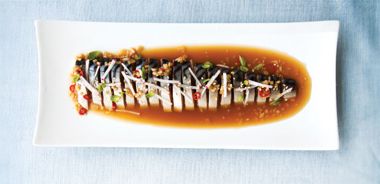Mackerel Ceviche

This wonderful no-cook starter relies on the acid in citrus and vinegar to “cook” the fish. This recipe is equally delicious made with skinless salmon instead of mackerel. Always choose the freshest fish available for this dish.
1 - 6 oz (170 g) mackerel fillet, skin on, pin bones removed
2 Tbsp (30 mL) fresh orange juice
2 Tbsp (30 mL) fresh lemon juice
2 Tbsp (30 mL) fresh lime juice
1 Tbsp (15 mL) low-sodium soy sauce or tamari
1 Tbsp (15 mL) sherry vinegar or red wine vinegar
1 Tbsp (15 mL) mirin or 1 tsp (5 mL) raw cane sugar
1 Tbsp (15 mL) shallot, finely diced
1 red Thai chili, thinly sliced
1/2 in (1.25 cm) piece of ginger, finely diced
2 radishes, trimmed and julienned (as garnish)
1/2 tsp (2 mL) fresh mint, finely chopped (as garnish)
Toasted sesame seeds (as garnish)
Place mackerel, skin side up, in shallow serving bowl or deep plate. Set aside.
In separate small bowl whisk together orange, lemon, and lime juice; soy sauce; sherry vinegar; mirin; shallot; chili; and ginger. Pour over mackerel, cover, and refrigerate for 1 hour.
Remove mackerel from marinade, reserving marinade, and place on clean cutting board. Starting at the tail, use your hands to peel away thin transparent membrane covering shiny blue skin. Cut mackerel fillet on diagonal into 1/2 in (1.25 cm) slices.
Place mackerel on serving plate and drizzle marinade on top, allowing it to pool under fish. Garnish with radish, mint, and sesame seeds (if using). Serve immediately.
Serves 4.
Each serving contains: 135 calories; 9 g protein; 8 g total fat (2 g sat. fat, 0 g trans fat); 8 g carbohydrates; 1 g fibre; 175 mg sodium
source: "Go Fish!", alive #356, June 2012





